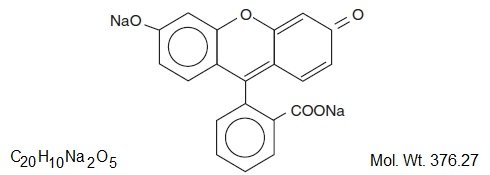Flurox Ophthalmic Solution: Package Insert / Prescribing Info
Package insert / product label
Generic name: fluorescein sodium and benoxinate hydrochloride
Dosage form: ophthalmic solution
Drug class: Ophthalmic diagnostic agents
Medically reviewed by Drugs.com. Last updated on Mar 3, 2025.
On This Page
Flurox Ophthalmic Solution Description
Flourescein Sodium and Benoxinate Hydrochloride Opthalmic Solution USP, 0.25%/0.4% is a disclosing agent with rapid anesthetic action of short duration.
Fluorescein Sodium is represented by the following structural formula:

Chemical Name: Spiro [isobenzofuran-1 (3H),9'-[9H] xanthene]-3-one, 3',6' dihydroxy, disodium salt.
Benoxinate Hydrochloride is represented by the following structural formula:

Chemical Name: 2-(Diethylamino) ethyl 4-amino-3butoxybenzoate monohydrochloride.
EACH mL CONTAINS:
ACTIVES: Fluorescein Sodium 2.5mg (0.25%), Benoxinate Hydrochloride 4mg (0.4%)
INACTIVES: Povidone, Boric Acid, Water For Injection. Hydrochloric Acid may be added to adjust pH (4.3 - 5.3).
PRESERVATIVE: Methylparaben 0.1%
Flurox Ophthalmic Solution - Clinical Pharmacology
This product is the combination of a disclosing agent with a rapidly acting anesthetic of short duration.
Indications and Usage for Flurox Ophthalmic Solution
For procedures requiring a disclosing agent in combination with a topical ophthalmic anesthetic agent such as
tonometry, gonioscopy, removal of corneal foreign bodies and other short corneal or conjunctival procedures.
Warnings
Prolonged use of a topical ocular anesthetic is not recommended. It may produce permanent corneal
opacification with accompanying visual loss. Avoid contamination - do not touch tip of sterile dropper
used to dispense solution to any surface. Replace container closure immediately after using.
Precautions
This product should be used cautiously and sparingly in patients with known allergies, cardiac disease, or
hyperthyroidism. The long-term toxicity is unknow; prolonged use may possible delay woundhealing. Although
exceedingly rare with ophthalmic application of local anesthetics, it should be borne in mind that systemic toxicity
manifested by central nervous sytem stimulation followed by depression may occur. Protection of the eye from
irritation, chemicals, foreign bodies and rubbing during the period of anesthesia is very important. Tonometers soaked
in sterilizing or detergent solutions should be thoroughly rinsed with sterile distilled water prior to use. Patients should
be advised to avoid touching the eye until the anesthsia has worn off.
Adverse Reactions/Side Effects
Occasional temporary stinging, burning, and conjunctival redness have been reported after use of ocular anesthetics,
as well as a rare, severe, immediate-type, apparent hyper-allergic corneal reaction, with acute, intense and diffuse
epithelial keratitis, a gray, ground glass appearance, sloughing of large areas of necrotic epithelium, corneal filaments
and someimes, iritis with descemetitis.
Allergic contact dermatitis with drying and fissuring of the fingertips has been reported.
To report SUSPECTED ADVERSE REACTIONS, contact Altaire Pharmaceuticals, Inc. at (631) 722-5988
Related/similar drugs
Flurox Ophthalmic Solution Dosage and Administration
Usual Dosage: Removal of foreign bodies and sutures, and for tonometry, 1 or 2 drops (in single instillations)
in each eye before operating.
How is Flurox Ophthalmic Solution supplied
Fluorescein Sodium and Benoxinate Hydrochloride Ophthalmic Solution USP, 0.25%/0.4% is supplied
in a glass bottle with a sterilized dropper in the following size: 5mL
| FLUROX
fluorescein sodium 2.5mg (0.25%), benoxinate hydrochloride 4mg (0.4%) solution |
|||||||||||||||
|
|||||||||||||||
|
|||||||||||||||
|
|||||||||||||||
|
|||||||||||||||
|
|||||||||||||||
| Labeler - OCuSOFT, Inc. (174939207) |

